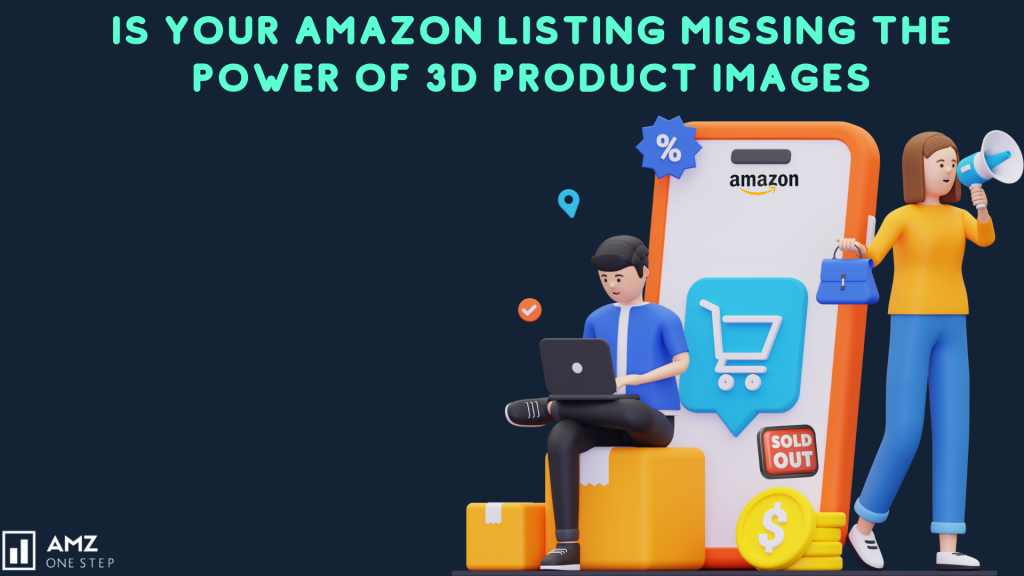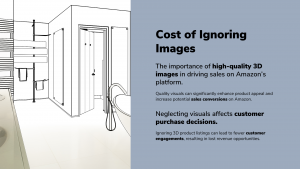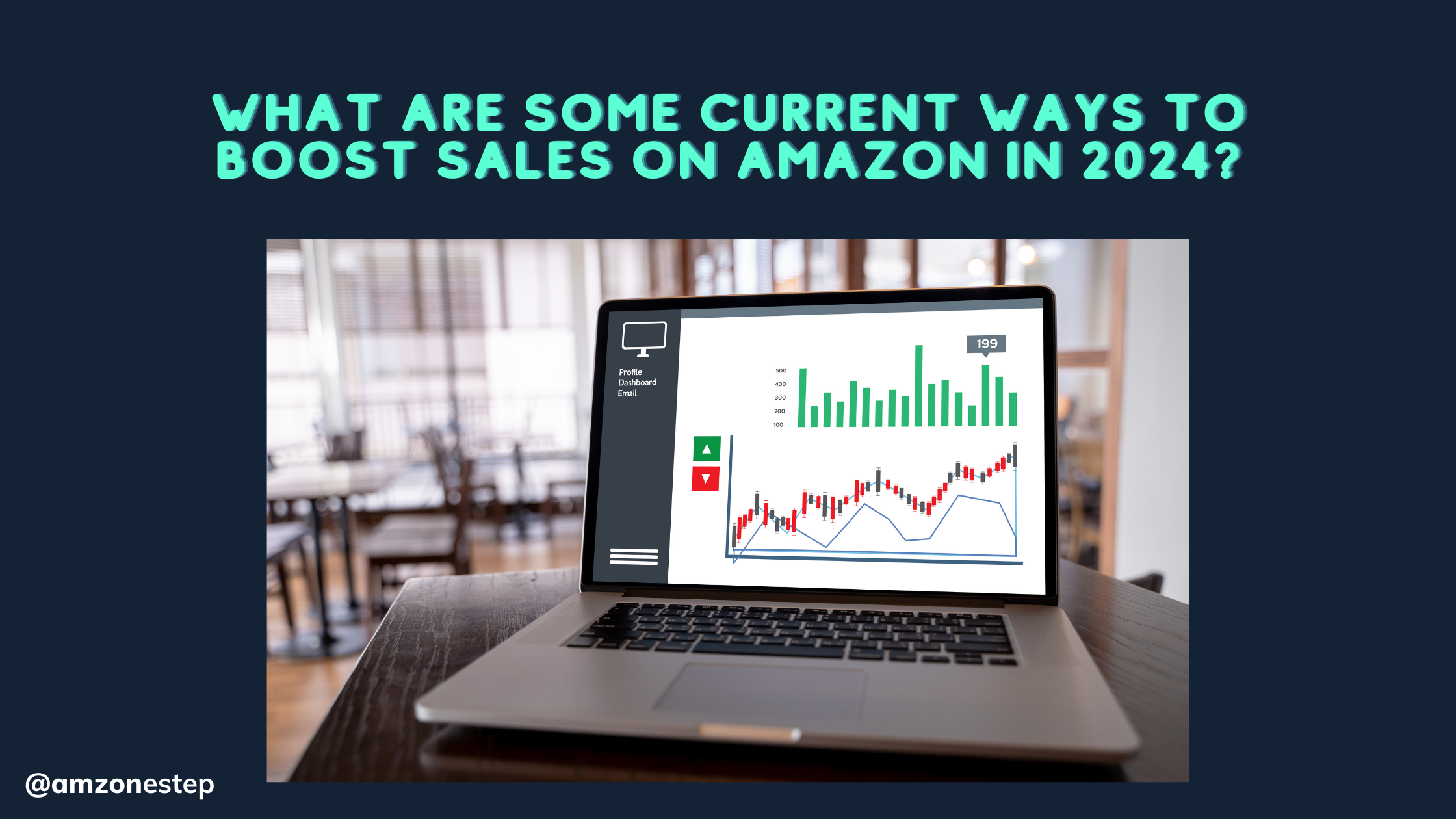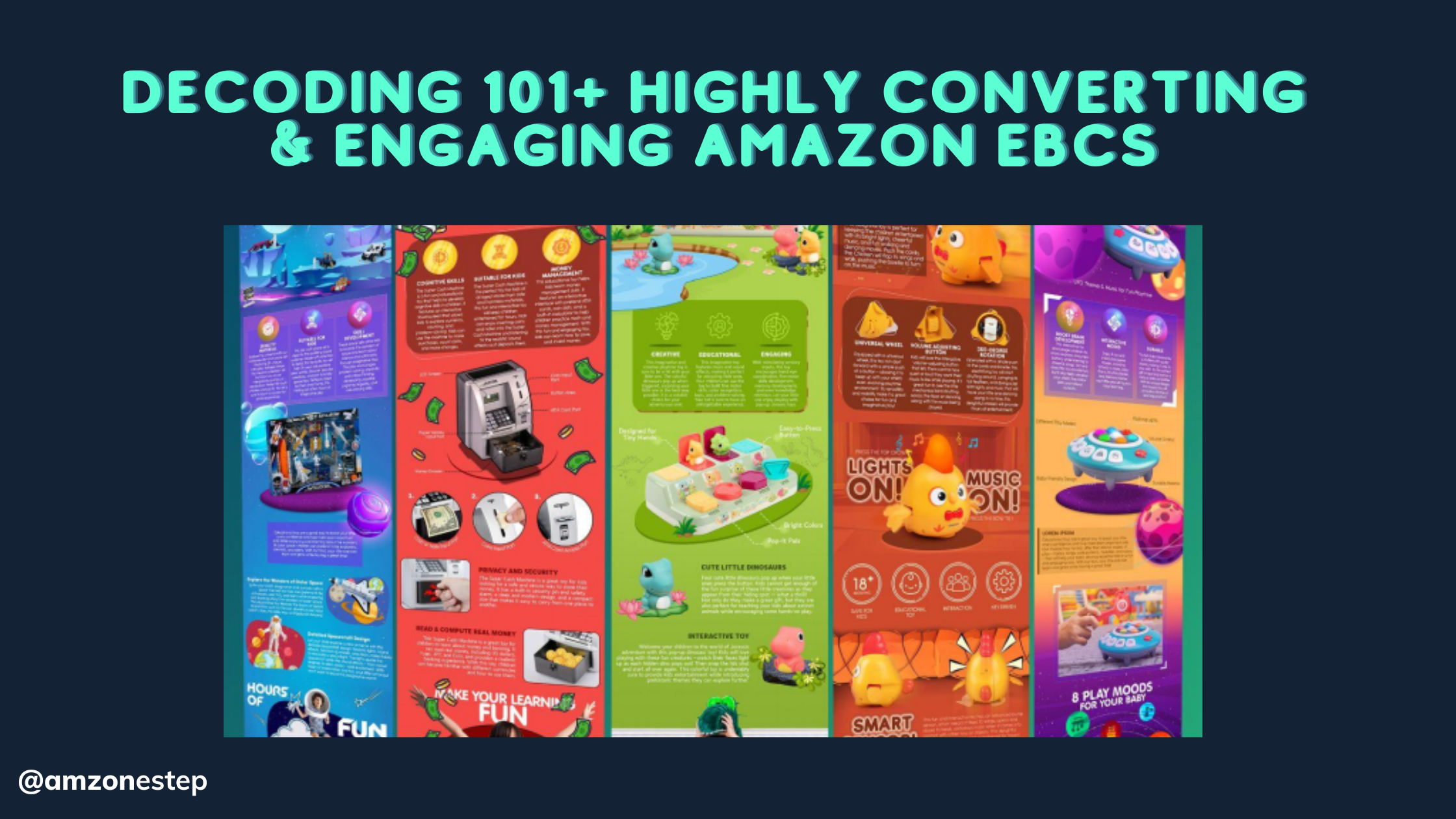Imagine your customers browsing Amazon, flooded with countless product options, each promising to be the best.
Now, picture them pausing at your listing, captivated by a sleek, interactive 3D product image that allows them to explore every detail. It’s like bringing the in-store shopping experience to their screens.
Buyers crave more engagement, deeper insights, and a level of confidence that only immersive visuals can deliver. If your Amazon listing isn’t leveraging the power of 3D product listing images, you might leave clicks, conversions, and revenue on the table.
Let’s explore why 3D product listing images are the future of online shopping and how they can transform your Amazon success.
Read More: FBA Product Photography: How To Make Your Main Listing Image Stand Out
Table of Contents
Why Amazon Shoppers Prefer Interactive Visuals
Interactive Visuals Bring Products to Life
No matter how high the image quality may be, static listing images cannot recreate the feel of touching and handling the product in person. Interactive visualizations bridge this gap by providing an analogue representation of products.
- For example, a customer views a 3D rendering of a leather handbag. Instead of guessing how the bag looks from any angle, customers will be able to rotate the model, zoom in on the stitching, or inspect the material texture. This immersive interaction enables customers to visualize owning and using a product, and makes the decision to buy that much more instinctive.
They Establish Trust and Credibility
Trust is the foundation of e-commerce, and consumers often remain hesitant to purchase when they are uncertain about what they are receiving. Interactivity in the image completely eradicates these question marks.
- Imagine a customer surfing through for running shoes. An interactive visual listing could enable a customer to see the shoe from every angle, to explore the sole design, and to understand how it fits on a model foot. This transparency will assure the shopper that their product is what is described, thereby cutting down on buyer’s remorse.
They Help Enable Informed Choices
One of the most useful features of interactive visuals is how they can also help shoppers to make side-by-side comparisons. Take a shopper who is deciding between two smartwatches. One listing has static photos, while the other includes a 360-degree view, complete with zoom and interactive labels that point to specific features.
The shopper may view a 360-degree model for even finer detail, such as the size of the screen and the placement of its buttons, without leaving the page. This level of detail helps in making more informed choices and preventing buyer’s remorse.
They Reduce Products Returned
Returns are a nuisance for online retailers, whose considerations are often linked to a mismatch in expectations. Interactive visuals confront this problem by offering accurate and detailed representations of the offered products.
With regard to an AR sofa, the customer can view how it will fit in the living room, ensuring before buying that it meets the space and decor criteria. The sale offers much less chance of dissatisfaction when the shopper already has a clear idea of what is delivered.
Read More: 7 Ways to Provide Product Reviews on Amazon
They Make Listings More Noticeable
A platform like Amazon is crowded, so gaining shoppers’ attention must be a priority. Interactive visuals catch the eye, as they present something more and exciting. Imagine scrolling through a list of Bluetooth speakers.
Most have standard photos, but there’s one that lets you turn the speaker so you can see the control panel close up, and even check its color options in real time. Of course, this is a list that demands to be clicked. It encourages more clicks and may convert into sales easily.
They Resonate with the Current Consumer Lifestyle
Shoppers are getting more visual and technology-oriented in today’s era. They expect their online shopping platforms to be as dynamic as other apps and games that they constantly use. Interactive listing images resonate with these needs as they make online shopping an exciting and exploratory process.
- For instance, a 3D model of a fitness tracker can help shoppers switch colors and view the product on a simulated virtual wrist, thus transforming the shopping journey into a personalized and contemporary one.
They Increase Engagement and Time Spent on Page
Interactive visuals certainly promote shoppers to spend more time on a product listing. For example, a customer examining a 3D model of a camera might rotate it to get a view of its lens, zoom in on the buttons, or even click on labels that explain its features.
Extended interaction does not only increase chances of conversion but also signals to the Amazon algorithm that the listing is very relevant and interesting enough to possibly enhance its ranking in search results.
They Stimulate the Emotions of Consumers
More often than not, consumer decisions are the result of emotions. Interactive graphics have this special ability to tap into feelings.
Think of a shopper browsing through the diamond engagement ring. A 360-degree view lets them see all the glinting of the gem in all directions, thus creating an emotional connection with the product. This feeling of amazement and desire makes the customer feel self-assured of their purchase and pushes them one click closer to the “Buy Now” button.
They Simplify Complex Products
Some products—such as home appliances or electronic gadgets—are too complicated to merely describe via words. Interactive visuals simplify complexities because they show rather than tell.
An example in point is a 3D model of a robotic vacuum cleaner that shows how it would clean, separate parts, and charge, all intuitively. Such visual storytelling is sure to evoke an understanding of the product’s functionality without having to decipher lengthy descriptions or technical jargon.
They Give a Sense of Possession
In addition to advertising a product, interactive graphics make the consumer envision it as a part of their life. A consumer viewing a 3D print of a kitchen appliance can turn it so that he can see how it would sit on his countertop.
AR tools can take this a step further by allowing him to superimpose the product in his home. The live experience develops a sense of ownership, making the purchase a very instinctive next step for visitors.
Read More: Why Amazon Video Product Ads Convert Better: The Power of Visual Storytelling
Boosting Click-Through Rates with 3D Listing images
A Window into Reality
What mostly interests customers during a web browsing is whether the product as it appears on the screen will be just so as they receive it. Traditional 2D listing images are rather good-looking but could not meet this concern in full.
They give a static perspective with essential details reserved, leaving customers unanswered questions. “Is this product really as good as it looks? Does it meet my expectations in terms of design, quality, and functionality?
” These doubts can force potential buyers to bypass your listing completely. 3D product listing images transform this experience by offering a lifelike, interactive view that approximates a hands-on examination. Envision shopping for headphones.
While a 2D image can show you the design, it won’t enable you to analyze how the ear cups swivel, the texture of the headband, or how the product folds for portability. With a 3D image, however, you can rotate the headphones, zoom in to have a closer look at materials, and even virtually hold the product.
This immersion reassures customers that they’re making an informed decision, significantly increasing the likelihood of them clicking your listing to learn more.
Engaging the Modern Shopper
Today’s shoppers, especially the Millennials and Gen Z, require so much more from their online experience. They want interactivity, engagement, and innovation, all things that mere listing images are not able to offer.
These consumers are digital natives who have grown up amidst touchscreens, augmented reality, and instant gratification. Hence, static listing images can no longer effectively compete for their attention. 3D listing images are a fulfillment of this need as it translates passive browsing into active exploration.
- For instance, using Amazon to find a desk lamp, the consumer can interact with a 3D image to see the angles of adjustment for the lamp, also to feel the metallic finish texture, or even to see the positioning of the light source. Compared to static visuals, where engagement is limited, 3D listing images engage the user with a level of ownership that cannot be achieved with static visuals.
This heightened interaction encourages buyers to click on your ad so they can learn more about your product’s attributes.
Overcoming Uncertainty
Uncertainty is the biggest hitch in e-commerce. The customer usually does not make a purchase because she fears that the offering might not live up to her expectations. Be it the quality, the dimensions or the compatibility, this uncertainty may result in abandoned carts and lost sales.
This challenge is addressed effectively by 3D product listing images because a customer gets a comprehensive and realistic image of the product. Let’s take an example of how a customer orders a sofa.
A 2D picture of the sofa might also indicate the color or design, but it wouldn’t depict its look from all sides or if it occupies the desired space. A 3D image will allow the customer to turn the sofa, zoom in on stitching details, and imagine it in a room setting.
This type of deep understanding gives the shopper confidence to click through your listing and get closer to buying.
Displaying Complex Features
Some products, like technology gadgets or machinery, have complex features that cannot be explained through static listing images. The functionality can be described, but it lacks the precision of vision that helps buyers fully understand these complexities.
- For example, a smartwatch may have several functions, from health monitoring to message receipt. No single 2D picture can adequately represent all its features.
A 3D image, though, lets customers interact with the product. They have a look at the buttons, display settings, and strap materials. So, they can experience it virtually: how it would look on the wrist and feel.
This interactive display presentation appeals to probing, detail-oriented shoppers and encourages them to click through your listing, where they’ll learn more about the product.
Standing Out in a Sea of Similarity
Amazon is one of the most competitive e-commerce platforms, with thousands of listings vying for customer attention. In this crowded marketplace, standing out is critical to success. 3D product listing images act as a magnet for attention.
They immediately differentiate your listing by providing a visually dynamic and interactive experience. For example, imagine two coffee makers listed side by side. One uses common 2D pictures that represent plain angles, while the other uses a 3D image with all the buttons, the water chamber, and the working of the equipment.
The latter not only grabs the attention but also sets curiosity, thus enhancing clickthrough rates and better chances to convert that customer.
Tapping into the Power of Curiosity
Curiosity is a powerful psychological stimulus that induces user behavior. Typically, the appearance of a 3D image of the product in front of a shopper provokes further interest and creates a need to “know more”. This feeling of curiosity persuades the shopper to read your listing and find out more about your product.
This is very effective for decorative or complex objects, like designer handbags. A 3D image can be viewed in fine detail to see the stitching, zippers, and inner pockets. This increases the desire to click through to your listing based on curiosity alone, so it will increase conversion rates as well.
Improving Brand Perception
Incorporating 3D listing images into your Amazon listings positions your brand as innovative and customer-focused. Shoppers associate high-quality visuals with premium products, and offering 3D listing images sends a strong signal that you prioritize their experience.
Consider a skin care company. The company is conveying authenticity and care through the 3D exhibit of its product’s packaging and texture.
Thus, the clicks are prompted by a positive perception – listings that look professional and of good quality. All this aids in building trust, an essential component in the competitive landscape of electronic commerce.
Reaching Mobile Shoppers
With mobile shopping being the primary means by which customers browse and purchase online, optimizing for small screens has become essential. Static listing images simply do not work well on mobile devices, forcing users to zoom disconcertingly or scroll through multiple angles.
The frictions are removed by 3D listing images because of the intuitive, intractable nature they have. For instance, in case a customer is looking for a smartwatch, they simply swipe and zoom through the product from their smartphone and can see everything up close.
They will stay longer on that page and therefore become more likely to click through to your listing and convert.
Using Emotional Connection
Shopping is often an emotive exercise. Customers do not just buy commodities-they buy what this commodity brings into their lives emotionally. 3D listing images do exceptionally well at creating a connection in this regard: they help the customer imagine himself using them.
- Imagine a toy store advertising a streamlined car model. A 3D image does not just look nice; it transports the purchaser into an imaginative world. Parents can envision their child playing with the toy, racing it across the living room floor. The emotional connection to this product makes it all the more appealing-a greater chance of a click and subsequently a sale.
Read More: How Can Amazon Sellers Scale Photography and Videography for Thousands of Products?
The Cost of Ignoring 3D Product Listing images on Amazon
With millions of listings vying for attention, the difference between booming sales and stagnant growth can mean the way a product is presented.
One of the most transformative trends in product presentation comes down to 3D listing images but still, many sellers rely on out-of-date, 2D visuals, never suspecting that this is sabotaging their success.
Not utilizing 3D product listings on Amazon is more than just a lost opportunity—it’s an expensive error. Let’s explore how neglecting this powerful tool can hurt your brand, sales, and reputation.
Losing Customer Engagement
Today’s shoppers crave engaging experiences. Static 2D listing images feel lifeless in comparison to 3D visuals that allow customers to interact, rotate, and zoom in on products. By not offering this immersive experience, you’re losing the attention of potential buyers.
- For example, imagine a customer browsing for a fitness tracker. Their front face is all that shows with a 2D image, making them assume anything about the strap design, button placement, or charging port.
A competitor’s use of 3D listing images turns the experience interactive, allowing the shopper to look over every feature. It’s little wonder which of these listings will hold the customer’s attention. A lackluster product is likely to be scrolled past, leaving you loss of clicks and sales.
Losses Compared to Competitors
Here, at Amazon, only the fittest listings survive. Giving a competitive edge is the adoption of 3D listing images. Listings are produced from day one that others would die for. If you stick with static visuals, you are giving share to your competition for prioritizing customer experience.
- Let’s use home décor as an example. A seller with 3D listing images of a lamp that includes texture, shade, and angles will pull ahead of one using flat, uninspiring photos. The outcome? The person with 3D seizes more eyeballs, achieves better click-through rates, and converts more transactions-all while your listing collects dust in the sea of non-viewers.
Wasted Opportunities on Increased Conversions
But once a customer clicks through to your listing, 3D listing images may seal the deal by providing an understanding of the deeper detail. Without this technology, your conversion rates may go stagnant or decline.
- For example, a customer searching for a carry-on luggage may not go through with a purchase because they cannot see the interior pockets or the tread mechanism of a wheel in photographs. A competitor using 3D view lets customers zoom in on every detail and removes the doubts to finalize a purchase. By not providing such clarity, you risk conversions to competitors who do.
Detrimental Impact on Trust of Customers
Online shoppers rely on listing images for decision making. Such poor or incomplete imagery is going to result in mismatched expectations, with the dissatisfaction and return largely damaging customer trust and your reputation at Amazon.
3D listing images reduce the risk as it gives an adequate and overall view about a product. Without them, the customer may be misled if what they get is different from the minimal listing images they saw online.
Negative reviews and low ratings can come a little too close, resulting in your brand facing such negativity and losing its chance to gain more customers.
Your listing on Amazon is not a sales pitch; it’s also a definition of your brand. Innovative, high-quality visuals indicate professionalism and reliability. Working with static listing images will quickly make your brand look outdated or untrustworthy.
For example, a tech brand selling headphones without 3D listing images might struggle to convey its innovative edge. Meanwhile, a competitor using 3D visuals creates an impression of cutting-edge technology and customer-centric design. This elevated brand perception not only drives sales but also fosters loyalty and trust.
Missing Mobile Shoppers
Mobile shopping is the new trend, and 3D listing images come as a perfect fit for the same. They provide an interactive experience that flows dynamically on these small screens, where static listing images do not reach such success. Withholding 3D listing images from view means disappointing your audience.
Imagine a consumer searching on his or her phone for something like a piece of jewelry. Static listing images require clumsy zooming and scrolling-annoying the user.
A competitor has 3D listing images, allowing the user to view the piece from every side through simple swipes. Ignoring 3D listing images might cause you to lose mobile shoppers to brands that care more about their needs.
Less Advertising ROI
For most sellers, Amazon advertising is a significant investment. But without the use of compelling visuals, most campaigns may not contribute adequately to the return they deliver. 3D listing images act like a click magnet. They help make your ads more effective.
If you are not using them, you may be wasting money on ads that bring only negligible traffic. Customers view static listing images as too unimpressive and thus look elsewhere to listings with more engaging graphics.
Without 3D visuals, you do not maximize your ad spend because you are simply missing the upward curve in return on investment.
Not Putting Your Business Up-to-Speed in Releasing Industry Trends
The e-commerce landscape constantly changes; staying ahead means staying on top of new trends. Offering 3D product listing images is the new standard. Without embracing it, your brand will find itself behind the curve.
There’s augmented reality and virtual reality – the future of shopping – in which 3D listing images are one step in that direction in getting your brand ready for what is new and what is to come. It’s easy to lose track of one’s way if no further steps are taken to keep up with this trend.
Increased Return Rates
Customers who can’t grasp your product by just looking at pictures probably will be disappointed after buying it. Thus, this leads to returns that are not healthy for the bottom line or your reputation.
A shopper buying a pair of shoes might misjudge the material or fit based on 2D visuals. A 3D image could have shown them every angle, helping them make an informed decision. By neglecting 3D listing images, you’re inviting unnecessary returns and eroding customer confidence.
Losing Long-Term Customer Loyalty
Here is the trust, satisfaction, and positive experience that builds loyalty among customers. Listings with 3D amazon images offer a transparent journey of shopping, which creates a stronger connection. You would miss repeat business without them as more competitors would invest in this technology.
The seamless experience with a 3D-enabled listing for the customer will be more likely to return to that seller for subsequent purchases. If your static listing images create frustration or doubt, then the customer may never come back. Ignoring 3D visuals could result in losing an entire lifetime of customer value rather than just one sale.
Read More: This Is What You Should Do If Someone Has Stolen Your Listing Images On Amazon
Amazon’s Policies on 3D Product Listing Images

Complies with Amazon’s High-Quality Image Guidelines
Amazon highlights highly on image quality to represent products accurately. In the context of 3D product listing images, at least 1,000 pixels on the longest side. This means the customers will be able to view the image with a resolution sharp enough to have a good interaction with and zoom in on.
In addition, 3D listing images must be rendered on a white background RGB 255, 255, 255 for consistency and professionalism as indicated in the Amazon image requirements. Renders of high quality will draw attention but pass through Amazon’s quality check as well to ensure your listing stays active.
3D Listing images Must Depict the Product Accurately
Accuracy is at the heart of Amazon’s image policy. This is particularly crucial with 3D listing images, which allow customers to have an interactive experience. Sellers must ensure that the 3D models mirror the product’s real-world details, from size and color to material texture.
Misrepresentation, such as exaggerating features, could result in complaints, returns, and even suspension of the product listing. For example, in a 3D model of a sofa, the actual upholstery, stitching, and dimensions should reflect exactly what one expects and gets out of their purchases.
A+ Content Compliance for 3D Listing images
A+ Content is a facility from Amazon for brand-registered sellers to include rich media such as 3D models within product descriptions. Even though Amazon does not state specifically about 3D listing images in its A+ Content, it does permit multimedia elements that will enhance the customer’s experience.
Sellers can add 3D visuals to show products from different angles and unique features. However, these have to be in Amazon’s prescribed standard of professional presentation and must be relevant to the product but cannot have external links or misleading claims.
The initial priority should be to educate and help the buyer in order to provide an ideal shopping experience.
Seamless Integration with AR View
Amazon’s AR View enables a customer to see how the product might look in their space through the use of augmented reality (AR). In categories like furniture and home décor, this is a very popular feature. It requires 3D models in glTF or USDZ formats.
The sellers must ensure their 3D models are compatible with Amazon’s AR platform. In addition, these models should be optimized to be of smaller file sizes in order not to slow down and yet maintain all the crucial details. Such experience will be engaging and increase conversion rates for sellers.
Interactive Media Has to Comply with All Amazon’s Restrictions
Amazon severely restricts any kind of interactive content, and 3D listing images belong to such a category.
These listing images should be static in nature on the listing but enable customers to rotate, zoom, and navigate through the product, while Amazon’s policy doesn’t allow models containing 3D which takes customers to third party sites.
Any of such functionality will have the listing flagged. The intent is to keep the shopping experience smooth by not taking the customer out of Amazon’s platform. They must ensure that the 3D models they add to listings do not interfere with Amazon’s internal functionality and don’t break the flow of purchasing.
Adherence to Amazon’s Misleading Content Policies
Amazon will hold sellers responsible for any misleading content or listing images. Sellers have to be sure that 3D models are not just accurate but also representative of the product’s actual features and capabilities.
- For instance, a 3D image of a smartphone must reflect the correct dimensions, relative position of the buttons, and other details of the screen. Discrepancies that magnify the product to be significantly different from what a customer will buy could lead to fines. Avoid these instances by ensuring that all details included in the 3D renders correspond to the actual product.
Consistent Visualization in both Mobile and Desktop Versions
Mobile shopping is growing, and Amazon would like to provide convenience across devices. 3D listing images need to be optimized to ensure seamless performances on mobile and desktop interfaces; they should not lag or become distorted.
Considering that most shoppers make purchases using their mobile devices, ensuring that the 3D product models load fast and remain interactive is crucial. The seller must ensure that his 3D listing images are responsive, while the zoom and rotate features work seamlessly, so the customer will have a great shopping experience across all platforms.
Leveraging 3D Listing images in Enhanced Brand Content (EBC)
Enhanced Brand Content (EBC) enables brand-registered sellers to incorporate listing images, text, and videos, which can offer a richer experience for the product.
Although not required or specifically called out in Amazon’s EBC guidelines, 3D listing images can be included as part of the definition of rich media if they add value to the customer experience.
The 3D model has to be relevant, bring additional insight into the product, and not be a substitute for the product’s actual image-2D. Sellers will be able to better illustrate the product features when using EBC together with 3D listing images, hence increasing the chances of maintaining a competitive edge.
Ethical and Legal Compliance of 3D Models
Using 3D product listing images entails that you are comfortable in respect to where you derive all the models being used. Amazon ensures that all listing images and content comply with laws on intellectual property. Sellers using third-party 3D models should have proper licensing or permission to use the visual assets.
Unauthorized use of 3D models will get taken down or you risk facing lawsuits; thus, making sure that you either design your own models or obtain a license to use models from someone else. All these ethical steps protect the seller’s listings from being taken offline due to potential legal issues.
Keeping Pace with the Ever-Changing Nature of Amazon’s Guidelines
The platform of Amazon is constantly changing, and it’s important for sellers to keep updated with the changes in its policies, especially concerning 3D visuals.
Although 3D listing images are not a must-to-have for most product listings, growing interactive shopping experience seems to make them an even bigger part of product listings sooner or later.
Sellers should monitor the Amazon news about new feature launches, policy updates, or new established standards so they do not fall out of compliance and take advantage of the new opportunities emerging. Proactive engagement with such changes will help sellers stay a step ahead of competition.
Read More: Incredibly Effective Free Amazon Features Every Seller Should Be Using
Why 3D Listing Images Are Essential for Technical Products
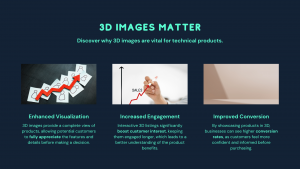
Better Product Understanding
Technical products like gadgets or electronics often contain a lot of complicated details that are difficult to describe using 2D listing images.
A 3D image would enable the consumer to touch and interact with the product, turn it around for every angle, zoom in to explore very minor components, and even try out some interactive features in a virtual situation.
- For example, when purchasing a smartwatch, a 3D model offers the customer an overview of how the product looks – from front and back, side to side, top to bottom, and from the perspective of the buttons, the display, and the band, so they know exactly what they’re getting.
Highlighting Unique Features and Functionality
Technical products are so advanced, it’s often hard to show the features using listing images or text: a good example is a high-tech drone with a camera that can rotate.
A 3D image will show how the camera moves and plays with the rest of the drone, giving a shopper an idea of the versatility of the product. Such detail will boost the confidence of a consumer in buying since they see all that the product can do.
Enhanced Customer Confidence
When purchasing technical products such as laptops, cameras, or tools, customers tend to be concerned about the constructional qualities and material quality. A 3D image sets such issues to rest by showing the textures, finishes, and building qualities.
- For instance, the 3D view of a laptop demonstrates to the customers how the case has an attractive premium finish and how the ports and buttons are arranged. For these reasons, customers can be assured about their purchase decision.
Size and Scale Demonstration
Among the top common concerns while purchasing technical products online, size is the most common one. With static listing images, there’s a lot of deception about the size of products, especially with items like speakers or refrigerators, or even power tools, which differ in dimension.
A 3D image would give the customer the chance to view it by rotating and zooming in on the product to determine its precise dimensions against other objects.
- For instance, when purchasing a pair of noise-canceling headphones, a 3D image will allow the shopper to see how well the ear cups fit around their ears, which allows them to better determine whether or not it should fit comfortably or appeal to their style.
Captivating Technologically Efficient Consumers
Customers today are more digitally literate than ever – Millennials and Gen Z have been well immersed in technology. They will expect as much interactivity during an online purchase; 3D listing images are perfect for meeting this expectation.
Whether they are purchasing a drone, a virtual reality headset, or an ultra-high-performance gaming PC, these shoppers want to experience the product before buying.
A 3D image allows for a more dynamic shopping experience, making the product feel more tangible and real, which is crucial for converting interested shoppers into buyers.
Visualization of Complex Components
Technical products usually contain many parts that move or have complex internals and cannot be well comprehended by any single image. A 3D image allows a customer to explore the inside of a product, helping them better understand how it works.
- Suppose, for instance, a 3D rendering of a mechanical watch. Customers can zoom in on intricately worked gear trains and fine craftsmanship; they also might be able to play with rotating elements-a feature traditional listing images simply cannot offer.
Trust through transparency
Transparency is very essential in the world of electronic commerce. As long as customers trust that the seller is providing them with a true, honest representation of the product, trust is built.
Through technical products, which often invest high sums of money, such a relationship becomes even more critical. In this regard, a 3D image allows customers to inspect the product from every angle, thus feeling confident about the purchase made.
- For example, an image of a 3D home security camera design shows the product’s design, lens, mounting system, and the integration of all features provided, which gives a point of trust about the quality and functionality of the product.
Demonstrate Compatibility and Customization
This works especially well for products with a larger system or offers customization options. For instance, if the shopper is looking at computer components like a graphics card or a motherboard to buy, he wants to know if the part will fit into the existing setup.
The 3D model lets the customer interact with the model, zoom in to analyze the size of the part, and look alongside other parts to check for compatibility. This is particularly important when buyers have specific needs regarding customization and fit in technical product categories.
Why 3D Product Listing images Are Ideal for Accessories
Highlighting Detail and Texture
Accessories, like jewelry, handbags, watches, and footwear, are often valued for their intricate details and textures. Traditional 2D listing images might fail to convey the full richness of materials such as leather, metal, or gemstones.
3D listing images allow customers to zoom in and rotate the product, enabling them to examine every detail closely.
- For example, when shopping for a designer handbag, a 3D image lets the customer inspect the stitching, zippers, and interior compartments—features that are essential when making a purchasing decision.
Providing a Comprehensive View of Dimensions and Fit
Many accessories, such as belts, hats, or sunglasses, require customers to visualize how the product will fit and look in real life. A 3D image allows shoppers to view the item from all angles, helping them gauge size and scale.
- For instance, a 3D image of a pair of sunglasses lets customers see how the frames wrap around the face, providing a clearer sense of fit compared to a flat image. This interactive experience can reduce hesitation and lead to higher conversion rates.
Making Accessories Look More Realistic
Aesthetics often drive consumers to buy accessories, and listing images are an important factor in a customer’s decision to buy. The way a 3D image presents the product makes it look more life-like.
Thus, when applying for earrings as a 3D image allows customers to manipulate the product by turning it around and, consequently, feel what that might be in differing lighting or on the ear. This realistic aspect can help stir up emotional response, which is essential in selling fashion accessories.
The Impact of 3D Listing Images on Seasonal Sales

Catching the Eye in the Sea of Sales
During the most important events like Black Friday, Cyber Monday, or Christmas, many listings come to marketplace sites such as Amazon. There is always a vast sea of similar-looking products, which may leave lesser-known items invisible.
2D listing images compete with hundreds of other listing images; however, 3D product listing images can create a visual dynamism that captures the gaze of the shopper.
From holiday gifting through smartwatches to summer gifting via sunglasses, a 3D image immediately grabs attention, so the product is much more likely to click and be further inspected.
Read More: The Secret to Higher Amazon Sales: Labeling Your Main Image
Creating a Sense of Urgency
Seasonal sales are often time-sensitive; this creates urgency with resultant quick decisions. 3D listing images, with their interactivity and detailed views, allow customers to clearly visualize the product more easily, reducing any hesitation they might have.
- For instance, a customer looking for a winter coat can interact with the product, zooming in and viewing the stitching, the fabric, and the design. This enhanced understanding helps them quickly make a purchasing decision. The fact that you can look at the product in better detail also makes buyers more assured about their selection, which is what they need to feel during peak season shopping promotions.
Seasonal Attributes
Some products are designed and engineered with seasonal attributes, whether a holiday-themed decor, a gadget for the summer, or winter clothing. Their 3D listing images allow you to emphasize such seasonal features, which static listing images cannot.
- For example, a 3D image of a Christmas tree decoration allows customers to view the intricate details of the design, the materials, and how the light elements shine, creating a more immersive experience. These detailed visuals help customers connect more with the product and see its unique seasonal features, which can be the deciding factor in a purchase.
Reinforce the Gift Experience
Seasonal sales with the holidays very much focus on gifts. Buyers want to be certain that what they are choosing as a gift is what they want for the recipient, most specially, a loved one or a close friend.
3D listing images allow customers to check out every detail of a product, which is especially important for items such as jewelry, electronics, or clothing.
- For instance, when purchasing a luxury watch as a gift, a person can scrutinize the details of craftsmanship in the 3D model, thus ensuring it meets his expectations. Such a high-definition close-up reduces uncertainty, so a buyer will be much more confident in choosing an excellent gift.
Boosting Interest with Limited Edition or Seasonal Products
Many brands create limited editions or have seasonal releases at a specific time of the year. Such items are often in demand, and a 3D image can make them all the more appealing by showcasing their unique features in an interactive, detailed way.
- For example, a 3D rendering of a limited-edition holiday-themed sneaker allows customers to rotate the shoe and examine special design features, like seasonal colors or exclusive materials. This facilitates interactivity when presenting limited-time or seasonal products sold on a short-term basis.
Minimizing Returns During Holidays
Among the biggest hassles for a business that accommodates seasonal sales, returns take the lead. Misleading listing images or misrepresentation of products may show dissatisfaction and returns, which are most costly during high-volume periods.
3D listing images of the products allow an easier representation of the product, thereby lessening confusion or mismatched expectations.
- For instance, upon viewing a 3D image of a pair of boots, a shopper can see the texture of the leather, the height of the heel, and the width of the boot, hence ensuring that the product meets the needs of the shopper. This clarity reduces the possibility of returns, which is so important during high-demand sales events.
Maximum Possible Shares via Social Media
Social media campaigns and promotions are also typical for a seasonal sale; 3D listing images are very shareable because of their interactive nature, better for social platforms like Instagram where an interaction with the content is the ultimate enjoyment.
Attention-grabbing is certain with a well-crafted 3D image of a holiday gift set or a limited-edition accessory that makes users want to share it with their friends and followers, thus increasing visibility and reach of your product.
Organic promotion results in more sales, especially if the product appeals to consumers visually and creates some buzz on social media during peak shopping periods.
Make your listings irresistible with AMZ One Step

Hi there! I’m the content marketing and branding specialist for AMZ One Step. I work hard to create engaging and informative content that helps our readers learn more about Amazon selling and how to make the most of their businesses. I love spending time with my family and exploring literary works when I’m not writing or working on projects.

